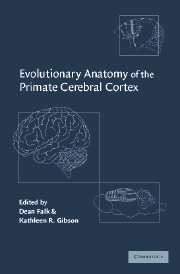Book contents
- Frontmatter
- Contents
- List of contributors
- Preface
- Prologue: Size matters and function counts
- Part I The evolution of brain size
- Part II Neurological substrates of species-specific adaptations
- Introduction to Part II
- 7 The discovery of cerebral diversity: an unwelcome scientific revolution
- 8 Pheromonal communication and socialization
- 9 Revisiting australopithecine visual striate cortex: newer data from chimpanzee and human brains suggest it could have been reduced during australopithecine times
- 10 Structural symmetries and asymmetries in human and chimpanzee brains
- 11 Language areas of the hominoid brain: a dynamic communicative shift on the upper east side planum
- 12 The promise and the peril in hominin brain evolution
- 13 Advances in the study of hominoid brain evolution: magnetic resonance imaging (MRI) and 3-D reconstruction
- 14 Exo-and endocranial morphometrics in mid-Pleistocene and modern humans
- Epilogue: The study of primate brain evolution: where do we go from here?
- Index
11 - Language areas of the hominoid brain: a dynamic communicative shift on the upper east side planum
Published online by Cambridge University Press: 07 October 2011
- Frontmatter
- Contents
- List of contributors
- Preface
- Prologue: Size matters and function counts
- Part I The evolution of brain size
- Part II Neurological substrates of species-specific adaptations
- Introduction to Part II
- 7 The discovery of cerebral diversity: an unwelcome scientific revolution
- 8 Pheromonal communication and socialization
- 9 Revisiting australopithecine visual striate cortex: newer data from chimpanzee and human brains suggest it could have been reduced during australopithecine times
- 10 Structural symmetries and asymmetries in human and chimpanzee brains
- 11 Language areas of the hominoid brain: a dynamic communicative shift on the upper east side planum
- 12 The promise and the peril in hominin brain evolution
- 13 Advances in the study of hominoid brain evolution: magnetic resonance imaging (MRI) and 3-D reconstruction
- 14 Exo-and endocranial morphometrics in mid-Pleistocene and modern humans
- Epilogue: The study of primate brain evolution: where do we go from here?
- Index
Summary
Recently it was demonstrated that brains of chimpanzees (Pan troglodytes) show a humanlike differentially enlarged left planum temporale, an area that in humans is part of the receptive ‘language’ region of the cerebral cortex (Gannon et al., 1998b). This new finding addressed a highly controversial issue within the disciplines of neurology, neurobiology, evolutionary biology, anthropology, linguistics and psychology, to name but a few. Prior to this finding it had been widely accepted that pronounced hemispheric asymmetry of this brain language region was unique to humans and, as such, could readily have been included as a component within the pervasive ‘human language organ’ (linguistics-based) concept formulated by Noam Chomsky (Chomsky, 1972). Not surprisingly, this prospective paradigm shift gave rise to many new questions and criticisms. For example, it is not clear whether this left hemisphere-lateralized language region is as remarkable in other closely related primates, particularly other great apes, but also lesser apes and even Old World monkeys. Based upon a century of human studies, it would appear reasonable to hypothesize that the markedly asymmetric planum temporale is involved with ape ‘language’ or other species specific, interindividual communication modalities. However, although this region is markedly anatomically lateralized to the left hemisphere in apes, it may not be functionally analogous. Further, as recent studies (Binder et al., 1996) have suggested, the planum temporale may not be involved with high-level receptive language processing in humans but may simply represent an early stage relay station.
- Type
- Chapter
- Information
- Evolutionary Anatomy of the Primate Cerebral Cortex , pp. 216 - 240Publisher: Cambridge University PressPrint publication year: 2001
- 7
- Cited by

